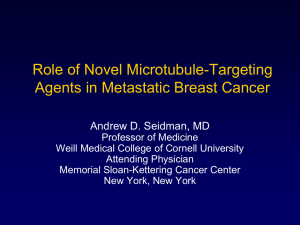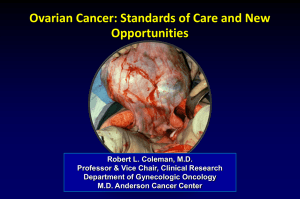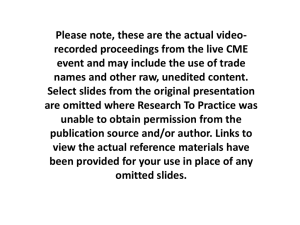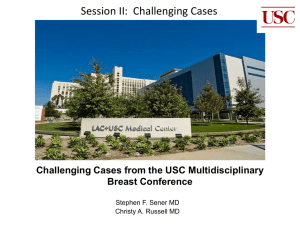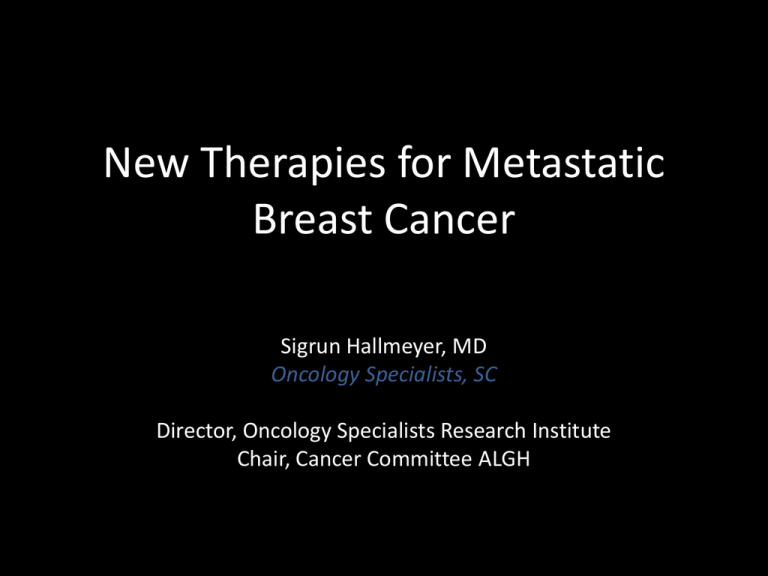
New Therapies for Metastatic
Breast Cancer
Sigrun Hallmeyer, MD
Oncology Specialists, SC
Director, Oncology Specialists Research Institute
Chair, Cancer Committee ALGH
Primary goals of systemic treatment
for metastatic breast cancer
• Prolongation of survival,
• Alleviation of symptoms, and
• Maintenance / improvement in quality of life, despite associated
treatment toxicity
Local therapies (XRT, surgery) can aid in the achievement of these
goals
• Oligometastasectomy associated with 5-10 % long-term DFS
• Probable survival improvement with resection of primary breast
malignancy in stage IV patients
Remove Primary
Some theoretical evidence why resection of the
primary tumor appears to improve survival:
• ? Ongoing dissemination of disease from the
primary
• ? Immunosuppressive or –regulatory effects
from primary tumor
• ? Production of growth factors by primary
tumor that promote growth of distant disease
Does aggressive local therapy improve
survival in metastatic breast cancer?
• METHODS: Stage IV breast cancer at initial diagnosis in
National Cancer Data Base (NCDB) between 1990 and 1993
• RESULTS: n=16,023 patients,
– 6861 (42.8%) either no operation or variety of
diagnostic/palliative procedures
– 9162 (57.2%) partial (3513) or total (5649) mastectomy
• Free surgical margins improved 3-year survival (26% vs
35%)
• Women treated with surgical resection with free margins,
compared with those not surgically treated, had superior
prognosis, with a hazard ratio of 0.61 (95% confidence
interval 0.58,0.65) even when adjusted for type /amount of
distant disease and use of systemic therapy
AUKhan SA, Stewart AK, Morrow MSO
Surgery. 2002;132(4):620 NWMH Chicago
Impact of Therapy
• Optimal measure of therapeutic efficacy is controversial
• Overall survival = gold standard for comparison of therapies
– Requires prolonged follow-up
– diluted by the effects of subsequent treatment
• progression-free survival [PFS], time to tumor progression
[TTP], or objective response rate [ORR] are suboptimal
surrogates for overall survival
• Objective response rates = relative treatment efficacy ≠
clinically meaningful increases in survival
• Symptom relief without measurable disease response and
achievement of stable disease are clinically relevant
The impact of new chemotherapeutic and hormone agents on
survival in a population-based cohort of women with
metastatic breast cancer
• 2150 patients with a first distant metastases diagnosed during 1 of the 4
cohort intervals were identified
– COHORT 1
1991/92
– COHORT 2
1994/95
– COHORT 3
1997/98
– COHORT 4
1999/2001
• Baseline characteristics between cohorts were similar, except a greater
proportion of the later cohorts received adjuvant chemotherapy (P <
.001), had positive estrogen receptor status (P = .01), and had a longer
median time from initial diagnosis to MBC (P < .001)
• Survival got progressively better over time
Cancer
Volume 110, Issue 5, pages 973–979, 1 September 2007
The impact of new chemotherapeutic and hormone agents on
survival in a population-based cohort of women with
metastatic breast cancer
• 2150 patients with a first distant metastases diagnosed during 1 of the 4
cohort intervals were identified
–
–
–
–
COHORT 1
COHORT 2
COHORT 3
COHORT 4
1991/92
1994/95
1997/98
1999/2001
438 d
450 d
564 d
667 d
• In multivariate analysis, the later cohorts were associated independently
with improved survival (P = .01 and P < .001, respectively).
Cancer
Volume 110, Issue 5, pages 973–979, 1 September 2007
The impact of new chemotherapeutic and hormone agents on
survival in a population-based cohort of women with
metastatic breast cancer
• 2150 patients with a first distant metastases diagnosed during 1 of the 4
cohort intervals were identified
– COHORT 1 1991/92
438 d
– COHORT 2 1994/95
450 d
– COHORT 3 1997/98
564 d
– COHORT 4 1999/2001
667 d
• In multivariate analysis, the later cohorts were associated independently
with improved survival (P = .01 and P < .001, respectively).
Cancer
Volume 110, Issue 5, pages 973–979, 1 September 2007
Prediction of Outcome
Patient
• Relapse-free interval ≥2 years more
favorable than a shorter time to relapse
• Metastases involving the chest wall, bones, or lymph
nodes better than hepatic and/or lymphangitic
pulmonary
• Patients with lymphangitic lung metastases, bone
marrow replacement, carcinomatous meningitis, or
significant liver metastases are in visceral crisis
worst prognostic group
Prediction of Outcome
Pathology
• Markers of increased cellular proliferation [IHC staining for the
proliferation antigen Ki67] associated with higher chemotherapy
response rates
• Gp170 over expression [drug efflux pump, MDR mediator], or
mutated p53 gene are less likely to respond to chemotherapy
• Strongest predictors ER, PR and Her2/neu status
– Hormone receptor positivity generally more favorable prognosis
– ER- and PR-positive tumors have significantly longer survival than single
hormone receptor-positive tumors (ER+/PR- or ER-/PR+)
• Patients with either HER2 overexpression or triple (ER, PR, HER2)negative metastatic breast cancer have a shorter median survival*
– Justifies need for re-biopsy
*Pre-Herceptin included
Prediction of Outcome
Pathology
• Markers of increased cellular proliferation [IHC staining for the
proliferation antigen Ki67] associated with higher chemotherapy
response rates
• Gp170 over expression [drug efflux pump, MDR mediator], or
mutated p53 gene are less likely to respond to chemotherapy
• Strongest predictors ER, PR and Her2/neu status
– Hormone receptor positivity generally more favorable prognosis
– ER- and PR-positive tumors have significantly longer survival than single
hormone receptor-positive tumors (ER+/PR- or ER-/PR+)
• Patients with either HER2 overexpression or triple (ER, PR, HER2)negative metastatic breast cancer have a shorter median survival*
– Justifies need for re-biopsy
*Pre-Herceptin included
Prediction of Response
• ER, PR, Her2/neu important factors in selecting
appropriate treatment 2013
• Future is here: molecular sub typing, pathway
recognition and mutational analysis
• Target finding and specific therapy development
•
•
•
•
•
Melanoma BRAF - vemurafenib
Lung ALK –Crizotinib
CML Ph* - imatinib
NHL CD20 – rituximab
Breast…
Prediction of Response
• ER, PR, Her2/neu important factors in selecting
appropriate treatment 2013
• Future is here: molecular sub typing, pathway
recognition and mutational analysis
• Target finding and specific therapy development
•
•
•
•
•
Melanoma BRAF - vemurafenib
Lung ALK –Crizotinib
CML Ph* - imatinib
NHL CD20 – rituximab
Breast… To Be Determined
Concepts of Chemotherapy Duration
• Optimal duration of chemotherapy for metastatic
breast cancer not known
• Trials of extended duration therapy demonstrated
improved PFS, but no overall survival
• Prolonged chemotherapy associated with significant
increase in toxicity, decreased quality of life.
• Clinical practice:
– Fixed time frame (~four to six months)
then stop
– treating to best response
– Treating to progressive disease, as long
as treatment is reasonably well tolerated
Duration of chemotherapy for metastatic breast
cancer: a systematic review and meta-analysis of
randomized clinical trials
• Published data from 11 trials (2269 patients)
• Patients were randomly assigned to longer versus shorter
duration of chemotherapy
• Trial designs heterogeneous, but most compared fixed
number of courses versus treatment until disease progression
• Longer duration chemotherapy associated with a statistically
significant 36 percent reduction in the risk of progression, and
a significant 9 percent reduction in the risk of death
J Clin Oncol. 2011;29(16):2144
Concept of Sequence
• No clearly defined optimal first-line regimen
• Patients with aggressive or symptomatic disease may
benefit from combination chemotherapy regimens or
single agents with higher response rates
• Response rates for doxorubicin are higher as first–line
therapy than when administered after progression on
paclitaxel (41 versus 30 percent)
• Anthracycline/taxane combinations have high RR and
improved PFS when compared to non-taxane
anthracycline combinations, but also significant toxicity
• OS not significantly affected by the order of administration
Anthracyclines
•
Doxorubicin
•
Epirubicin
•
Pegylated liposomal doxorubicin
•
Mitoxantrone
Taxanes
•
Paclitaxel
•
Docetaxel
•
Albumin-bound paclitaxel
Anti-metabolites
•
Capecitabine
•
Gemcitabine
•
Methotrexate
•
Pemetrexed
Other single agents
•
Eribulin
•
•
•
•
Etoposide orally
Cyclophosphamide
Cisplatin
Fluorouracil
•
Ixabepilone
•
Irinotecan
•
Vinorelbine
Hormonal therapy
•
SERM
•
AI
•
Fulvestrant
•
Combinations
Chemotherapy combinations
•
CAF/FAC (cyclophosphamide/doxorubicin/fluorouracil)
•
FEC (fluorouracil/epirubicin/cyclophosphamide)
•
AC (doxorubicin/cyclophosphamide)
•
EC (epirubicin/cyclophosphamide)
•
AT (doxorubicin/docetaxel; doxorubicin/paclitaxe)
•
CMF (cyclophosphamide/methotrexate/fluorouracil)
•
Docetaxel/capecitabine
•
GT (gemcitabine/paclitaxel)
•
Ixabepilone/capecitabine
Biologic agents
•
Bevacizumab with paclitaxel
HER2-positive disease
•
Trastuzumab with:
•
Paclitaxel with or without carboplatin
•
Docetaxel
•
Vinorelbine
•
Capecitabine
•
Lapatinib with:
–
–
–
•
•
Capecitabine
Paclitaxel
Trastuzumab
Pertuzumab
T-DM1
Triple negative
•
PARP
Anthracyclines
•
Doxorubicin
•
Epirubicin
•
Pegylated liposomal doxorubicin
•
Mitoxantrone
Taxanes
•
Paclitaxel
•
Docetaxel
•
Albumin-bound paclitaxel
Anti-metabolites
•
Capecitabine
•
Gemcitabine
•
Methotrexate
•
Pemetrexed
Other single agents
•
Eribulin
•
•
•
•
Etoposide orally
Cyclophosphamide
Cisplatin
Fluorouracil
•
Ixabepilone
•
Irinotecan
•
Vinorelbine
Hormonal therapy
•
SERM
•
AI
•
Fulvestrant
•
Combinations
Chemotherapy combinations
•
CAF/FAC (cyclophosphamide/doxorubicin/fluorouracil)
•
FEC (fluorouracil/epirubicin/cyclophosphamide)
•
AC (doxorubicin/cyclophosphamide)
•
EC (epirubicin/cyclophosphamide)
•
AT (doxorubicin/docetaxel; doxorubicin/paclitaxe)
•
CMF (cyclophosphamide/methotrexate/fluorouracil)
•
Docetaxel/capecitabine
•
GT (gemcitabine/paclitaxel)
•
Ixabepilone/capecitabine
Biologic agents
•
Bevacizumab with paclitaxel
HER2-positive disease
•
Trastuzumab with:
•
Paclitaxel with or without carboplatin
•
Docetaxel
•
Vinorelbine
•
Capecitabine
•
Lapatinib with:
–
–
–
•
•
Capecitabine
Paclitaxel
Trastuzumab
Pertuzumab
T-DM1
Triple negative
•
PARP
Anthracyclines
•
Doxorubicin
•
Epirubicin
•
Pegylated liposomal doxorubicin
•
Mitoxantrone
Taxanes
•
Paclitaxel
•
Docetaxel
•
Albumin-bound paclitaxel
Anti-metabolites
•
Capecitabine
•
Gemcitabine
•
Methotrexate
•
Pemetrexed
Other single agents
•
Eribulin
•
•
•
•
Etoposide orally
Cyclophosphamide
Cisplatin
Fluorouracil
•
Ixabepilone
•
Irinotecan
•
Vinorelbine
Hormonal therapy
•
SERM
•
AI
•
Fulvestrant
•
Combinations
Chemotherapy combinations
•
CAF/FAC (cyclophosphamide/doxorubicin/fluorouracil)
•
FEC (fluorouracil/epirubicin/cyclophosphamide)
•
AC (doxorubicin/cyclophosphamide)
•
EC (epirubicin/cyclophosphamide)
•
AT (doxorubicin/docetaxel; doxorubicin/paclitaxe)
•
CMF (cyclophosphamide/methotrexate/fluorouracil)
•
Docetaxel/capecitabine
•
GT (gemcitabine/paclitaxel)
•
Ixabepilone/capecitabine
Biologic agents
•
Bevacizumab with paclitaxel
HER2-positive disease
•
Trastuzumab with:
•
Paclitaxel with or without carboplatin
•
Docetaxel
•
Vinorelbine
•
Capecitabine
•
Lapatinib with:
–
–
–
Capecitabine
Paclitaxel
Trastuzumab
• Pertuzumab
• T-DM1
Triple negative
• PARP
Anthracyclines
•
Doxorubicin
•
Epirubicin
•
Pegylated liposomal doxorubicin
•
Mitoxantrone
Taxanes
•
Paclitaxel
•
Docetaxel
•
Albumin-bound paclitaxel
Anti-metabolites
•
Capecitabine
•
Gemcitabine
•
Methotrexate
•
Pemetrexed
Other single agents
•
Eribulin 11/2010
•
•
•
•
Etoposide orally
Cyclophosphamide
Cisplatin
Fluorouracil
•
Ixabepilone 10/2007
•
Irinotecan
•
Vinorelbine
Hormonal therapy
•
SERM
•
AI
•
Fulvestrant
•
Combinations 06/2012
Chemotherapy combinations
•
CAF/FAC (cyclophosphamide/doxorubicin/fluorouracil)
•
FEC (fluorouracil/epirubicin/cyclophosphamide)
•
AC (doxorubicin/cyclophosphamide)
•
EC (epirubicin/cyclophosphamide)
•
AT (doxorubicin/docetaxel; doxorubicin/paclitaxe)
•
CMF (cyclophosphamide/methotrexate/fluorouracil)
•
Docetaxel/capecitabine
•
GT (gemcitabine/paclitaxel)
•
Ixabepilone/capecitabine
Biologic agents
•
Bevacizumab with paclitaxel 10/2011
HER2-positive disease
•
Trastuzumab with:
•
Paclitaxel with or without carboplatin
•
Docetaxel
•
Vinorelbine
•
Capecitabine
•
Lapatinib with:
– Capecitabine 03/2007
–
–
Paclitaxel
Trastuzumab
• Pertuzumab 06/2012
• T-DM1 2013?
Triple negative
• PARP
Anthracyclines
•
Doxorubicin
•
Epirubicin
•
Pegylated liposomal doxorubicin
•
Mitoxantrone
Taxanes
•
Paclitaxel
•
Docetaxel
•
Albumin-bound paclitaxel
Anti-metabolites
•
Capecitabine
•
Gemcitabine
•
Methotrexate
•
Pemetrexed
Other single agents
•
Eribulin 11/2010
•
•
•
•
Etoposide orally
Cyclophosphamide
Cisplatin
Fluorouracil
•
Ixabepilone 10/2007
•
Irinotecan
•
Vinorelbine
Hormonal therapy
•
SERM
•
AI
•
Fulvestrant
•
Combinations 06/2012
Chemotherapy combinations
•
CAF/FAC (cyclophosphamide/doxorubicin/fluorouracil)
•
FEC (fluorouracil/epirubicin/cyclophosphamide)
•
AC (doxorubicin/cyclophosphamide)
•
EC (epirubicin/cyclophosphamide)
•
AT (doxorubicin/docetaxel; doxorubicin/paclitaxe)
•
CMF (cyclophosphamide/methotrexate/fluorouracil)
•
Docetaxel/capecitabine
•
GT (gemcitabine/paclitaxel)
•
Ixabepilone/capecitabine
Biologic agents
•
Bevacizumab with paclitaxel 10/2011
HER2-positive disease
•
Trastuzumab with:
•
Paclitaxel with or without carboplatin
•
Docetaxel
•
Vinorelbine
•
Capecitabine
•
Lapatinib with:
– Capecitabine 03/2007
–
–
Paclitaxel
Trastuzumab
• Pertuzumab 06/2012
• T-DM1 2013?
Triple negative
• PARP
Avastin
• Bevacizumab - mAB against VEGF – inhibits angiogenesis.
As monotherapy in MBC only modest activity (RR 9%)
• First Line MBC ECOG trial (E2100), 722 randomly assigned
to bevacizumab and paclitaxel or paclitaxel alone
• COMBINATION significantly increased the response rate (37
versus 21 percent) and PFS (11.8 versus 5.9 months), but no
significant increase in median survival (26.7 versus 25.2
months).
Preliminary FDA approval
was granted for the combination
of first line paclitaxel and
bevacizumab
Avastin
• Likewise, PFS was increased when bevacizumab was
combined with docetaxel (AVADO) and investigatorselected chemotherapy in the RIBBON-1 (first-line) and
RIBBON-2 (second-line) trials
• Pooled analysis of first line treatment from E2100,
AVADO, and RIBBON-1 showed significantly improved
median PFS (9.2 versus 6.7 months), but not overall
survival (26.7 versus 26.4 months)
In November 2011
the FDA revoked the approval
due to lack of survival
Anthracyclines
•
Doxorubicin
•
Epirubicin
•
Pegylated liposomal doxorubicin
•
Mitoxantrone
Taxanes
•
Paclitaxel
•
Docetaxel
•
Albumin-bound paclitaxel
Anti-metabolites
•
Capecitabine
•
Gemcitabine
•
Methotrexate
•
Pemetrexed
Other single agents
•
Eribulin 11/2010
•
•
•
•
Etoposide orally
Cyclophosphamide
Cisplatin
Fluorouracil
•
Ixabepilone 10/2007
•
Irinotecan
•
Vinorelbine
Hormonal therapy
•
SERM
•
AI
•
Fulvestrant
•
Combinations 06/2012
Chemotherapy combinations
•
CAF/FAC (cyclophosphamide/doxorubicin/fluorouracil)
•
FEC (fluorouracil/epirubicin/cyclophosphamide)
•
AC (doxorubicin/cyclophosphamide)
•
EC (epirubicin/cyclophosphamide)
•
AT (doxorubicin/docetaxel; doxorubicin/paclitaxe)
•
CMF (cyclophosphamide/methotrexate/fluorouracil)
•
Docetaxel/capecitabine
•
GT (gemcitabine/paclitaxel)
•
Ixabepilone/capecitabine
Biologic agents
•
Bevacizumab with paclitaxel 10/2011
HER2-positive disease
•
Trastuzumab with:
•
Paclitaxel with or without carboplatin
•
Docetaxel
•
Vinorelbine
•
Capecitabine
•
Lapatinib with:
– Capecitabine 03/2007
–
–
Paclitaxel
Trastuzumab
• Pertuzumab 06/2012
• T-DM1 2013?
Triple negative
• PARP
Eribulin
• Non-taxane microtubule inhibitor inhibits
the growth phase of the microtubule and
arrests the cell cycle at the G2/M phase
Phase II study of eribulin mesylate in patients with MBC previously
treated with an anthracycline, a taxane, and capecitabine
• Single-arm, open-label phase II study
• Primary end point objective response rate (ORR)
• N=269 enrolled patients , median of four prior chemotherapy
regimens, received eribulin for a median of four cycles.
• ORR by independent review 9.3%, stable disease (SD) rate
46.5%, and clinical benefit rate (complete response + PR + SD
> or = 6 months) was 17.1%.
• Median duration of response was 4.1 months, and
progression-free survival was 2.6 months. Median overall
survival was 10.4 months.
• Neutropenia (54%; febrile neutropenia, 5.5%), leukopenia
(14%), and asthenia/fatigue (10%; no grade 4); grade 3
neuropathy occurred in 6.9% of patients (no grade 4).
J Clin Oncol. 2010 Sep 1;28(25):3922-8
Graph (eligible population, response by independent review) showing change in tumor size
from baseline to nadir (each bar represents a patient; n = 250; 19 patients did not have
assessable tumor measurements after the baseline assessment).
Cortes J et al. JCO 2010;28:3922-3928
©2010 by American Society of Clinical Oncology
Anthracyclines
•
Doxorubicin
•
Epirubicin
•
Pegylated liposomal doxorubicin
•
Mitoxantrone
Taxanes
•
Paclitaxel
•
Docetaxel
•
Albumin-bound paclitaxel
Anti-metabolites
•
Capecitabine
•
Gemcitabine
•
Methotrexate
•
Pemetrexed
Other single agents
•
Eribulin 11/2010
•
•
•
•
Etoposide orally
Cyclophosphamide
Cisplatin
Fluorouracil
•
Ixabepilone 10/2007
•
Irinotecan
•
Vinorelbine
Hormonal therapy
•
SERM
•
AI
•
Fulvestrant
•
Combinations 06/2012
Chemotherapy combinations
•
CAF/FAC (cyclophosphamide/doxorubicin/fluorouracil)
•
FEC (fluorouracil/epirubicin/cyclophosphamide)
•
AC (doxorubicin/cyclophosphamide)
•
EC (epirubicin/cyclophosphamide)
•
AT (doxorubicin/docetaxel; doxorubicin/paclitaxe)
•
CMF (cyclophosphamide/methotrexate/fluorouracil)
•
Docetaxel/capecitabine
•
GT (gemcitabine/paclitaxel)
•
Ixabepilone/capecitabine
Biologic agents
•
Bevacizumab with paclitaxel 10/2011
HER2-positive disease
•
Trastuzumab with:
•
Paclitaxel with or without carboplatin
•
Docetaxel
•
Vinorelbine
•
Capecitabine
•
Lapatinib with:
– Capecitabine 03/2007
–
–
Paclitaxel
Trastuzumab
• Pertuzumab 06/2012
• T-DM1 2013?
Triple negative
• PARP
Ixabepilone
• Mechanism of Action: Epothilone B analog;
binds to the beta-tubulin subunit of the
microtubule, arresting the cell cycle at the
G2/M phase and inducing apoptosis.
• Activity in taxane-resistant cells has been
demonstrated
Ixabepilone
• Phase II study, 126 patients with MBC previously treated
with an anthracycline, a taxane, and capecitabine
• median of three prior chemotherapy regimens
• ORR by independent review was 11.5%
• 50% of patients achieved SD (14.3% achieved SD ≥ 6
months)
• CBR was 25%.
• Peripheral neuropathy was reported by 60% of patients
(13% grade 3, 1% grade 4),
• 79% neutropenia (31% grade 3, 23% grade 4). Febrile
neutropenia was reported in four patients.
J Clin Oncol. 2007 Aug 10;25(23):3421-7. Epub 2007 Jul 2.
Best response from baseline in radiographic measurements of target lesions.
Denduluri N et al. JCO 2007;25:3421-3427
©2007 by American Society of Clinical Oncology
Anthracyclines
•
Doxorubicin
•
Epirubicin
•
Pegylated liposomal doxorubicin
•
Mitoxantrone
Taxanes
•
Paclitaxel
•
Docetaxel
•
Albumin-bound paclitaxel
Anti-metabolites
•
Capecitabine
•
Gemcitabine
•
Methotrexate
•
Pemetrexed
Other single agents
•
Eribulin 11/2010
•
•
•
•
Etoposide orally
Cyclophosphamide
Cisplatin
Fluorouracil
•
Ixabepilone 10/2007
•
Irinotecan
•
Vinorelbine
Hormonal therapy
•
SERM
•
AI
•
Fulvestrant
•
Combinations 06/2012
Chemotherapy combinations
•
CAF/FAC (cyclophosphamide/doxorubicin/fluorouracil)
•
FEC (fluorouracil/epirubicin/cyclophosphamide)
•
AC (doxorubicin/cyclophosphamide)
•
EC (epirubicin/cyclophosphamide)
•
AT (doxorubicin/docetaxel; doxorubicin/paclitaxe)
•
CMF (cyclophosphamide/methotrexate/fluorouracil)
•
Docetaxel/capecitabine
•
GT (gemcitabine/paclitaxel)
•
Ixabepilone/capecitabine
Biologic agents
•
Bevacizumab with paclitaxel 10/2011
HER2-positive disease
•
Trastuzumab with:
•
Paclitaxel with or without carboplatin
•
Docetaxel
•
Vinorelbine
•
Capecitabine
•
Lapatinib with:
– Capecitabine 03/2007
–
–
Paclitaxel
Trastuzumab
• Pertuzumab 06/2012
• T-DM1 2013?
Triple negative
• PARP
TYKERB Inhibits Tyrosine
Kinase Intracellularly
As a small molecule, TYKERB1:
• Crosses the cell membrane and
intracellularly binds
to the receptor’s TK domain2
• Directly inhibits TK
phosphorylation3
• Stops ensuing signal transduction
that results in malignant
behavior3
1. TYKERB [package insert]. Research Triangle Park, NC: GlaxoSmithKline; 2010.
2. Rowinsky EK. The Oncologist. 2003;8(suppl 3):5-17.
3. Xia W et al. Oncogene. 2002;21:6255-6263.
34
EGF100151 Study
Study Design
•Progressive, HER2+
MBC or LABC
•Previously treated with
anthracycline, taxane
and trastuzumab*
•No prior capecitabine
Stratification:
•Disease sites
•Stage of disease
R
A
N
D
O
M
I
Z
E
N=528
•Lapatinib 1250 mg po qd continuously +
Capecitabine 2000 mg/m2/d po days 114 q 3 wk
•Capecitabine 2500 mg/m2/d po days 114 q 3 wk
Patients on treatment until progression
or unacceptable toxicity, then followed
for survival
*Trastuzumab must have been administered for metastatic disease.
Data on File, GlaxoSmithKline. Geyer C, et al. NEJM 2006;355:2733-2743.
Therapy with Lapatinib Resulted in a Significant Improvement in
Time to Progression (2 of 2)
Investigator Assessment
Lapatinib +
Capecitabine
Capecitabine
No. of pts
198
201
Progressed or died
121
126
Median TTP, wk
18.3
23.9
Hazard ratio (95% CI)
0.72 (0.56, 0.92)
P value (log-rank, 1-sided)
0.00762
2012 ASCO Chicago
Lapatinib plus Trastuzumab
• Dual targeting of HER2 may be synergistic
• Phase III trial, N=296 patients with MBC with disease progression following ≥1
prior trastuzumab-containing therapy
• regimens randomly assigned to treatment with lapatinib alone or in
combination with trastuzumab
• Combination of lapatinib and trastuzumab resulted in:
– Improved PFS (HR 0.74, 95% CI 0.58-0.94; median, 11 versus 8 weeks)
– Improved OS (HR 0.74, 95% CI 0.57-0.97; median, 14 versus 10 months
J Clin Oncol. 2010;28(7):1124.
Anthracyclines
•
Doxorubicin
•
Epirubicin
•
Pegylated liposomal doxorubicin
•
Mitoxantrone
Taxanes
•
Paclitaxel
•
Docetaxel
•
Albumin-bound paclitaxel
Anti-metabolites
•
Capecitabine
•
Gemcitabine
•
Methotrexate
•
Pemetrexed
Other single agents
•
Eribulin 11/2010
•
•
•
•
Etoposide orally
Cyclophosphamide
Cisplatin
Fluorouracil
•
Ixabepilone 10/2007
•
Irinotecan
•
Vinorelbine
Hormonal therapy
•
SERM
•
AI
•
Fulvestrant
•
Combinations 06/2012
Chemotherapy combinations
•
CAF/FAC (cyclophosphamide/doxorubicin/fluorouracil)
•
FEC (fluorouracil/epirubicin/cyclophosphamide)
•
AC (doxorubicin/cyclophosphamide)
•
EC (epirubicin/cyclophosphamide)
•
AT (doxorubicin/docetaxel; doxorubicin/paclitaxe)
•
CMF (cyclophosphamide/methotrexate/fluorouracil)
•
Docetaxel/capecitabine
•
GT (gemcitabine/paclitaxel)
•
Ixabepilone/capecitabine
Biologic agents
•
Bevacizumab with paclitaxel 10/2011
HER2-positive disease
•
Trastuzumab with:
•
Paclitaxel with or without carboplatin
•
Docetaxel
•
Vinorelbine
•
Capecitabine
•
Lapatinib with:
– Capecitabine 03/2007
–
–
Paclitaxel
Trastuzumab
• Pertuzumab 06/2012
• T-DM1 2013?
Triple negative
• PARP
mAB
Dimerization Inhibitor
Antibody-Drug
Conjugate
E-Journal ASCO 2010
Pertuzumab plus Trastuzumab
• CLEOPATRA Phase III trial, n=808 women with HER2-positive
metastatic breast cancer
• First-line treatment with trastuzumab, docetaxel with
randomization to pertuzumab versus placebo
• Significant improvement in median PFS (19 versus 12 months)
• Trend towards improvement in OS
• Significant improvement in ORR (80 versus 69%)
• Similar rates of left ventricular dysfunction (1 versus 2 percent)
N Engl J Med. 2012 Jan;366(2):109-19. Epub 2011 Dec 7
Overall Survival.
Baselga J et al. N Engl J Med 2012;366:109-119.
Anthracyclines
•
Doxorubicin
•
Epirubicin
•
Pegylated liposomal doxorubicin
•
Mitoxantrone
Taxanes
•
Paclitaxel
•
Docetaxel
•
Albumin-bound paclitaxel
Anti-metabolites
•
Capecitabine
•
Gemcitabine
•
Methotrexate
•
Pemetrexed
Other single agents
•
Eribulin 11/2010
•
•
•
•
Etoposide orally
Cyclophosphamide
Cisplatin
Fluorouracil
•
Ixabepilone 10/2007
•
Irinotecan
•
Vinorelbine
Hormonal therapy
•
SERM
•
AI
•
Fulvestrant
•
Combinations 06/2012
Chemotherapy combinations
•
CAF/FAC (cyclophosphamide/doxorubicin/fluorouracil)
•
FEC (fluorouracil/epirubicin/cyclophosphamide)
•
AC (doxorubicin/cyclophosphamide)
•
EC (epirubicin/cyclophosphamide)
•
AT (doxorubicin/docetaxel; doxorubicin/paclitaxe)
•
CMF (cyclophosphamide/methotrexate/fluorouracil)
•
Docetaxel/capecitabine
•
GT (gemcitabine/paclitaxel)
•
Ixabepilone/capecitabine
Biologic agents
•
Bevacizumab with paclitaxel 10/2011
HER2-positive disease
•
Trastuzumab with:
•
Paclitaxel with or without carboplatin
•
Docetaxel
•
Vinorelbine
•
Capecitabine
•
Lapatinib with:
– Capecitabine 03/2007
–
–
Paclitaxel
Trastuzumab
• Pertuzumab 06/2012
• T-DM1 2013 ?
Triple negative
• PARP
Anthracyclines
•
Doxorubicin
•
Epirubicin
•
Pegylated liposomal doxorubicin
•
Mitoxantrone
Taxanes
•
Paclitaxel
•
Docetaxel
•
Albumin-bound paclitaxel
Anti-metabolites
•
Capecitabine
•
Gemcitabine
•
Methotrexate
•
Pemetrexed
Other single agents
•
Eribulin 11/2010
•
•
•
•
Etoposide orally
Cyclophosphamide
Cisplatin
Fluorouracil
•
Ixabepilone 10/2007
•
Irinotecan
•
Vinorelbine
Hormonal therapy
•
SERM
•
AI
•
Fulvestrant
•
Combinations 06/2012
Chemotherapy combinations
•
CAF/FAC (cyclophosphamide/doxorubicin/fluorouracil)
•
FEC (fluorouracil/epirubicin/cyclophosphamide)
•
AC (doxorubicin/cyclophosphamide)
•
EC (epirubicin/cyclophosphamide)
•
AT (doxorubicin/docetaxel; doxorubicin/paclitaxe)
•
CMF (cyclophosphamide/methotrexate/fluorouracil)
•
Docetaxel/capecitabine
•
GT (gemcitabine/paclitaxel)
•
Ixabepilone/capecitabine
Biologic agents
•
Bevacizumab with paclitaxel 10/2011
HER2-positive disease
•
Trastuzumab with:
•
Paclitaxel with or without carboplatin
•
Docetaxel
•
Vinorelbine
•
Capecitabine
•
Lapatinib with:
– Capecitabine 03/2007
–
–
•
Paclitaxel
Trastuzumab
Pertuzumab 06/2012
02/21/2013
• T-DM1
Triple negative
• PARP
T-DM1
• Trastuzumab emtansine: antibody-drug conjugate composed of
trastuzumab, a thioether linker, and a derivative of the
antimitotic agent, maytansine
• EMILIA: phase III trial, n=978 patients with HER2-positive breast
cancer previously treated with trastuzumab and a taxane, and
randomly assigned to treatment with T-DM1 or the combination
of capecitabine plus lapatinib
• Improved PFS (10 versus 6 months)
• Improved median OS (31 versus 25 months)
• Improvement in the ORR (44 versus 31%)
• Most common toxicity with T-DM1 was thrombocytopenia (13
versus 0.2 % with XL), LVEF decline to <50% was low (2
percent/each arm)
2012 ASCO Chicago
T-DM1
• Trastuzumab emtansine: antibody-drug conjugate composed of
trastuzumab, a thioether linker, and a derivative of the
antimitotic agent, maytansine
• EMILIA: phase III trial, n=978 patients with HER2-positive breast
cancer previously treated with trastuzumab and a taxane, and
randomly assigned to treatment with T-DM1 or the combination
of capecitabine plus lapatinib
• Improved PFS (10 versus 6 months)
• Improved median OS (31 versus 25 months)
• Improvement in the ORR (44 versus 31%)
• Most common toxicity with T-DM1 was thrombocytopenia (13
versus 0.2 % with XL), LVEF decline to <50% was low (2
percent/each arm)
T-DM1
• Trastuzumab emtansine: antibody-drug conjugate composed of
trastuzumab, a thioether linker, and a derivative of the
antimitotic agent, maytansine
• EMILIA: phase III trial, n=978 patients with HER2-positive breast
cancer previously treated with trastuzumab and a taxane, and
randomly assigned to treatment with T-DM1 or the combination
of capecitabine plus lapatinib
• Improved PFS (10 versus 6 months)
• Improved median OS (31 versus 25 months)
• Improvement in the ORR (44 versus 31%)
• Most common toxicity with T-DM1 was thrombocytopenia (13
versus 0.2 % with XL), LVEF decline to <50% was low (2
percent/each arm)
PARP Inhibitors
• Inhibitors of poly (adenosine diphosphate-ribose)
polymerase (involved in the molecular events leading to
cell recovery from DNA damage)
• particularly useful in BRCA-mutated breast cancer
(majority triple negative, defective DNA repair
mechanism)
• not commercially available , but several in clinical trials
PARP Inhibitors
• Olaparib (400 mg po bid) was administered to women with
BRCA1- and/or BRCA2-deficient, advanced breast cancer (>50
percent triple-negative) in single arm study
–
–
–
–
ORR 41 percent
PFS of 5.7 months,
fatigue, nausea, and vomiting.
A separate study found olaparib had no activity outside of patients
with BRCA mutations
• Veliparib (ABT-888) was tested in combination with
temozolomide (alkylating agent) in 41 women with advanced
triple-negative breast cancer
– any activity concentrated only among patients with BRCA
mutations, in whom the overall response and clinical benefit rates
were 37.5 and 62.5 percent, respectively.
• Iniparib failed to show any activity in large (n=519) phase III
trial with triple negative breast cancer, cytotoxicity probably
not driven by PARP inhibition
Anthracyclines
•
Doxorubicin
•
Epirubicin
•
Pegylated liposomal doxorubicin
•
Mitoxantrone
Taxanes
•
Paclitaxel
•
Docetaxel
•
Albumin-bound paclitaxel
Anti-metabolites
•
Capecitabine
•
Gemcitabine
•
Methotrexate
•
Pemetrexed
Other single agents
•
Eribulin 11/2010
•
•
•
•
Etoposide orally
Cyclophosphamide
Cisplatin
Fluorouracil
•
Ixabepilone 10/2007
•
Irinotecan
•
Vinorelbine
Hormonal therapy
•
SERM
•
AI
•
Fulvestrant
•
Combinations 06/2012
Chemotherapy combinations
•
CAF/FAC (cyclophosphamide/doxorubicin/fluorouracil)
•
FEC (fluorouracil/epirubicin/cyclophosphamide)
•
AC (doxorubicin/cyclophosphamide)
•
EC (epirubicin/cyclophosphamide)
•
AT (doxorubicin/docetaxel; doxorubicin/paclitaxe)
•
CMF (cyclophosphamide/methotrexate/fluorouracil)
•
Docetaxel/capecitabine
•
GT (gemcitabine/paclitaxel)
•
Ixabepilone/capecitabine
Biologic agents
•
Bevacizumab with paclitaxel 10/2011
HER2-positive disease
•
Trastuzumab with:
•
Paclitaxel with or without carboplatin
•
Docetaxel
•
Vinorelbine
•
Capecitabine
•
Lapatinib with:
– Capecitabine 03/2007
–
–
Paclitaxel
Trastuzumab
• Pertuzumab 06/2012
• T-DM1 02/2013
Triple negative
• PARP
Potential Cross-Talk Between Signal
Transduction and Endocrine Pathways1
Growth factor
TYKERB
IGFR
Estrogen
P
Plasma
membrane
EGFR / HER2
PP
P
P
SOS
RAS
RAF
PI3-K
Letrozole
ER
Cell
survival
Akt
MEK P
P
p90RSK
Cytoplasm
P
P
ER
P
P
ER
p160
CBP
P
52
1. Adapted from Johnston S. Clin Cancer Res. 2005;11:889S-899S.
MAPK P
Basal
transcription
machinery
Nucleus
ERE
P
ER target gene transcription
Cell
growth
Lapatinib Combined With Letrozole
Versus Letrozole and Placebo as FirstLine Therapy for Postmenopausal
Hormone Receptor-Positive Metastatic
Breast Cancer1
Stephen Johnston, John Pippen, Jr, Xavier Pivot, Mikhail Lichinitser,
Saeed Sadeghi, Veronique Dieras, Henry Leonidas Gomez, Gilles Romieu,
Alexey Manikhas, M. John Kennedy, Michael F. Press, Julie Maltzman, Allison
Florance, Lisa O'Rourke, Cristina Oliva, Steven Stein, Mark Pegram
1. Johnston S et al. J Clin Oncol. 2009;27:5538-5546.
Progression-Free Survival: HER2+ Population1
Median PFS, months
Hazard ratio (95% CI)
Letrozole
(n=108)
Letrozole +
TYKERB
(n=111)
3.0*
8.2†
0.71 (0.53, 0.96)
P value
0.019
29%
TYKERB +
Letrozole
Improvement
in PFS vs
Letrozole
Time From Randomization (Months)
*13 weeks (95% CI; 12.0, 23.7) Letrozole.
†35.4 weeks (95% CI; 24.1, 39.4) letrozole + TYKERB2.
1. Johnston S et al. J Clin Oncol. 2009;27:5538-5546.
2. TYKERB [package insert]. Research Triangle Park, NC: GlaxoSmithKline; 2010.
Progression-Free Survival: HER2+ Population1
Median PFS, months
Hazard ratio (95% CI)
Letrozole
(n=108)
Letrozole +
TYKERB
(n=111)
3.0*
8.2†
0.71 (0.53, 0.96)
P value
0.019
29%
TYKERB +
Letrozole
Improvement
in PFS vs
Letrozole
Time From Randomization (Months)
*13 weeks (95% CI; 12.0, 23.7) Letrozole.
†35.4 weeks (95% CI; 24.1, 39.4) letrozole + TYKERB2.
1. Johnston S et al. J Clin Oncol. 2009;27:5538-5546.
2. TYKERB [package insert]. Research Triangle Park, NC: GlaxoSmithKline; 2010.
Response Rate: HER2+ Population
(n=219)1,2
P = 0.021
30
% of Patients
25
27.9%2
20
(95% CI; 19.8, 37.2)
15
10
14.8%2
5
(95% CI; 8.7, 22.9)
0
Overall Response Rate
Letrozole
Letrozole + TYKERB
1. Johnston S et al. J Clin Oncol. 2009;27:5538-5546.
2. TYKERB [package insert]. Research Triangle Park, NC: GlaxoSmithKline; 2010.
56
Fulvestrant and AI
Step up Hormonal Therapy
mTOR
Mammalian
Target
Of
Rapamycin
AI plus mTOR
• Exemestane plus everolimus
• BOLERO-2 trial n=724 women with MBC who
progressed on anastrazole
• Patients randomly assigned to exemestane alone or
exemestane plus everolimus
• Combination :
– Improvement in PFS (median, 7.8 versus 3.2 months)
– Higher ORR (13.6 versus 1.7 percent)
• Stomatitis (8%), dyspnea (4%), noninfectious
pneumonitis (3%), and elevated liver enzymes (3%)
SABCS 12/2011; NEJM 2/9/2012
Kaplan–Meier Plot of Progression-free Survival.
Baselga J et al. N Engl J Med 2012;366:520-529.
Anthracyclines
•
Doxorubicin
•
Epirubicin
•
Pegylated liposomal doxorubicin
•
Mitoxantrone
Taxanes
•
Paclitaxel
•
Docetaxel
•
Albumin-bound paclitaxel
Anti-metabolites
•
Capecitabine
•
Gemcitabine
•
Methotrexate
•
Pemetrexed
Other single agents
•
Eribulin 11/2010
•
•
•
•
Etoposide orally
Cyclophosphamide
Cisplatin
Fluorouracil
•
Ixabepilone 10/2007
•
Irinotecan
•
Vinorelbine
Hormonal therapy
•
SERM
•
AI
•
Fulvestrant
•
Combinations 06/2012
Chemotherapy combinations
•
CAF/FAC (cyclophosphamide/doxorubicin/fluorouracil)
•
FEC (fluorouracil/epirubicin/cyclophosphamide)
•
AC (doxorubicin/cyclophosphamide)
•
EC (epirubicin/cyclophosphamide)
•
AT (doxorubicin/docetaxel; doxorubicin/paclitaxe)
•
CMF (cyclophosphamide/methotrexate/fluorouracil)
•
Docetaxel/capecitabine
•
GT (gemcitabine/paclitaxel)
•
Ixabepilone/capecitabine
Biologic agents
•
Bevacizumab with paclitaxel 10/2011
HER2-positive disease
•
Trastuzumab with:
•
Paclitaxel with or without carboplatin
•
Docetaxel
•
Vinorelbine
•
Capecitabine
•
Lapatinib with:
– Capecitabine 03/2007
–
–
Paclitaxel
Trastuzumab
• Pertuzumab 06/2012
• T-DM1 02/ 2013
Triple negative
• PARP
Conclusions
• Metastatic breast cancer is biologically, pathologically
and molecularly very heterogeneous disease
• Local therapies including surgical resection of the
primary malignancy have impact on outcome
• A “whole stable” of hormonal, chemotherapeutic and
targeted agents is at our disposal – duration and
sequence of therapy remains undefined
• New drugs are being developed in rapid pace,
sometimes outpacing our approval safeguards
• Combinations of “old drugs” and “old with new” drugs
can have significant impact on outcome
Conclusions continued
• Overall Survival assessment becomes
increasingly difficult to use as study endpoint,
but surrogate markers of efficacy have severe
limitations
• Despite these challenges, significant progress
has been made not only in terms of longevity,
but also QOL for the many women affected by
MBC
Conclusions continued
• As our understanding of the inner workings of
breast cancer cells improves, we discover the
possibility for true targeted and personalized
therapies
• Once these are defined and optimized, it is
truly believable that MBC can become a
curable condition
Conclusions continued
• As our understanding of the inner workings of
breast cancer cells improves, we discover the
possibility for true targeted and personalized
therapies
• Once these are defined and optimized, it is
truly believable that MBC can become a
curable condition
Thank you.
Sigrun Hallmeyer, MD
Oncology Specialists, SC
Director, Oncology Specialists Research Institute
Chair, Cancer Committee ALGH
Phone 847-268-8200
shallmeyer@oncmed.net


